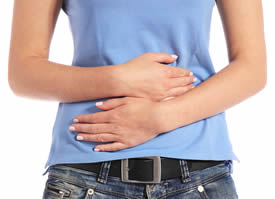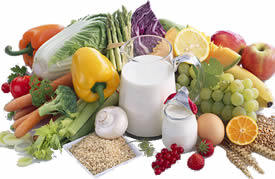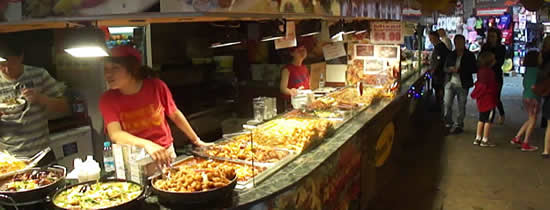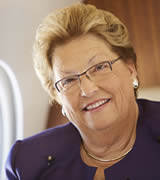Vacation Season
Or should I say Traveler’s Tummy Season, Montezuma’s Revenge Season or Where is the Nearest Bathroom Season?
The mere lifestyle of our industry - travel, travel and more travel, might make us think we’re immune to ‘traveler’s tummy’ when on a holiday. We anticipate and plan for summer holidays all year long. We invest a great deal of time, money, energy, and planning to have the perfect time away from work; time to unwind, regroup, refresh, and rejuvenate our body, mind, and soul.
The last thing you want to encounter while on holiday are digestive issues that cause you to spend your vacation time in or near a toilet.
It’s not that the food around the world is dangerous or bad for you. You’re on holiday. You’re on a culinary adventure, experimenting with new foods, new cocktails, regional delicacies. Your body is not accustomed to the microbiological make-up of the water, foods, and ingredients that cause you gastrointestinal problems.
I’m not saying that some food is not contaminated and toxic, but the majority of traveler’s tummy is due to the fact that - through lack of exposure - you’re more sensitive to certain microorganisms found in the food and water at your vacation spot.
I have some helpful, common sense ideas for you, your family, your passengers and flight crew to prevent the gastrointestinal disaster from occurring.
I referred to the Center for Disease Control’s (CDC) website guidelines for travelers, The Food Traveler’s Handbook, and the basic food safety guidelines set forth in the World Health Organization’s websites. The information is accurate, and current. It is easy to access and free to use. The CDC keeps a listing of all food borne outbreaks (current and past including location, number infected and source of outbreak), tainted food supplies, recalls and areas where water quality is either proven unsafe or where caution is suggested. The CDC also monitors and reports all diseases such as typhoid, and hepatitis. You need not be afraid to experiment and enjoy the flavors of the globe; you must teach your eyes to look at things a bit differently to assess the risks in your current environment. The CDC further suggests that you exercise a reasonable amount of vigilance in making food choices as you travel.
As noted in all food safety training programs, those at most risk for foodborne illness are the pregnant, children under six years of age, the elderly, and those with weakened immune systems. The traveling regimen our flight crews and passengers follow is rough even for the healthiest travelers. Flight crews, schedulers, and others involved in the flow of food must address these same issues on a daily basis . . . always on their highest guard.
But now it’s vacation time, your guard is down. It's easy to neglect proper nutrition; eating irregular meals and sleeping irregular schedules, enjoying excess cocktails, or existing for days on the same poor foods can cause traveler’s tummy and compromise the healthiest immune system. It is important to try to maintain a well-balanced diet while on holiday, just as you struggle to do while traveling for work. Be sure to get your protein. If not meat, look for other proteins; sports bars, protein bars, eggs, nuts, lentils and tofu. AND STAY HYDRATED! Drink lots of (safe) water. Fun in the sun will quickly dehydrate you.
Assess the risks
While there is no guaranteed way to avoid getting sick from food, either at home or traveling, there are foods you should look at carefully before eating. You must assess the risk, and make the final decision based on the information you have at hand. With training, you can make informed decisions. The foods, their cooking, cleaning, and sanitizing processes all play a role in your decision. You will learn these processes and their importance when you take a food safety class. I would like to suggest that you train your eyes on new way to look at the environment around you for safety and for security.
Number ONE: Start by washing your hands before you eat. If the water is questionable, use bottled water and hand sanitizer several times to loosen the dirt on your hands and wipe with a disposable towel. Sanitizers will not remove dirt from hands.
Liquids
To ensure you end your vacation healthy and relaxed, one of the top things to do is drink lots of safe, filtered water. According to the CDC, the most common source of dietary problems while traveling is drinking water - which includes ice. Not only a potential for a gastrointestinal issue, but, water in your mouth from a shower, a lake, ocean can wreak havoc on your body and you could suffer for days. Watch for posted signs which state the area is safe to swim.
Avoid anything that includes water or fresh herbs as ingredients such as salsa, chutney, and other sauces unless they are prepared safely. Condiments such as mayonnaise, ketchup and salad dressings are safest in sealed packages. According to the CDC, you can drink soda, but only if it comes in a sealed can or bottle; soda from a fountain is an absolute no-no.
As a catering source with our own lids to put liquids in bottles and the new soda stream tabletop dispensers available to anyone, I would caution against bottles and go just for cans. My caution comes from thinking someone may make their own sodas with unfiltered water and add a fresh top to a used bottle.
Coffee and tea are generally harmless, but it's best to take your hot drinks black, without potentially contaminated or unpasteurized milk. Cream from sealed containers, if pasteurized, is usually safe. This brings me to the next suggestion:
Dairy and Vegetables
Avoid raw or unpasteurized dairy products and fresh squeezed fruit and vegetable juices. Raw, unpasteurized dairy, including cheese and yogurt can transport dangerous bacteria such as salmonella, e-coli, and listeria, and is a major cause of food-borne illness. Many countries have different pasteurization processes and different standards. Freshly squeezed juices may contain fruits and vegetables that were washed with contaminated water.
“Cook it, wash it, peel it or forget it." is what many of us have heard over the years as a rule of thumb for eating in faraway places. Freshly cooked foods are less likely to have contaminants, and raw foods such as salads, and fruits and vegetables without peels, are often likely culprits for trouble. Fruits and vegetables you can peel yourself are usually safe. Beware of those cooked and prepared in dirty contaminated water.
With the current trends to have a soft cooked egg on top of a salad this next suggestion is in the forefront of warnings. In their tips for travelers’ health, the CDC, World Health Organization and most government food safety agencies warn against eating raw or partially cooked eggs. This includes sauces containing eggs such as hollandaise and freshly prepared mayonnaise.
Seafood
There should be a big warning sign over seafood in menus. Since I love seafood of all types I would probably be one of those to eat it. Because fish accumulate contaminants from a wide variety of sources, seafood dishes are notorious for causing intestinal problems.
The CDC says that smaller fish tend to be safer because they have stored fewer contaminants. Fish organs and shellfish (such as clams, mussels and oysters) are usually best avoided because they are bottom feeders ingesting the “trash” off the bottom of the ocean. They are bacteria breeding grounds when partially cooked, so you should probably say no to raw oysters when you travel or are on vacation. Raw or partially cooked meat also puts you at high risk of tapeworm.
Cold meat platters, deli meat style sandwiches, cheeses, buffet foods and unsealed mayonnaise are often covered with widespread growing bacteria. The educated choice is yours. Assess your risk. On a good note, nuts and other shelled foods are usually a good choice.
Street Food
Sources disagree about consumption of street foods. Some say street food is generally safer to eat than restaurant food, because you can see the food being made in front of you. But I haven’t seen the flow of food, the preparation areas, the storage areas, and their overall concern for the food. I just see the cart. Assess the situation. Is the cart busy, going through a lot of food, serving the food either very hot or very cold. If the cart is dirty or damaged, then you might safely assume that their preparation and storage areas are as well.

The same goes for a restaurant. Eat your meals during a traditional meal time to get fresh food that hasn’t been sitting around for hours waiting for a patron. Check the outside of the restaurant, look at the condition of the interior; dirty or clean, in good repair or not, the bathrooms clean or dirty? All of these give your eyes a chance to assess the risk and make the best decision for that time and place with the information you have at hand.
It all boils down to you making an informed decision. I know there are places that I visually scan and decide against eating food in. I may take a risk if I am very hungry or thirsty that in another case I might not. Educate yourself, educate your eyes to see telltale signs of potential problems which might lead to traveler’s tummy or other dreaded infections or disease. The only thing worse than getting sick when you travel would be not exposing yourself to the fantastic foods of the world, so while exercising caution, make sure not to get too unreasonable.
Travel safe and be well.

BlueSky Business Aviation News | 8th August 2019 | Issue #522
Share this article
About Paula Kraft . . . Paula Kraft is the founding partner of the DaVinci Inflight Training Institute located in Fort Lauderdale, Florida and the founder/president of Tastefully Yours Catering, an aviation specific caterer, located in Atlanta, Georgia for over 35 years. Paula is active with many aviation and catering-related groups including the International Caterers Association, the International Inflight Food Service Association and is a board member of Women in Corporate Aviation. She is the past chair of the NBAA Flight Attendant Committee Caterer’s Working Group for 15 years perfecting unique catering training sessions for NBAA conferences and events. Currently, she serves on the NBAA Flight Attendant Advisory Committee and is a member of the Training and Safety Subcommittee. Paula was a founding member of the Steering committee for the creation of a European Flight Attendant Committee and conference and serves as a subject matter expert to the board of International Standard for Business Aircraft Handlers (IS-BAH). After founding Tastefully Yours Catering, she has been offering culinary and food safety related training to the general aviation community. With a strong dedication to improving catering safety, risk mitigation and safe food handling, she developed and introduced the concept of “catering safety management systems”. As a certified food safety instructor, Paula offers catering SMS and culinary classes for all aviation professionals. Paula’s first-hand experience, business acumen, research, and relationships make her an industry expert - one which allows her to share information that will help raise the professional training level for flight attendants today that will reduce the risk of food-related concerns tomorrow. From Paula . . . I have coordinated training programs and clinics for NBAA and EBAA conference attendees for over 10 years, created mentoring programs for caterers and flight attendants to broaden their aviation culinary skills, and to assist them in adapting to the unique challenges and constraints found in catering for general aviation. I recognize the need for training and have worked closely with flight departments, flight crews, schedulers and customer service reps at the FBOs to ensure that catering specific training provides information and skills necessary to reduce risk while assisting them in their job duties that include safe food handling, catering security, accurate transmission of food orders, and safe food production, packaging and delivery. I fell into aviation catering quite by accident. I was the in-house caterer and bakery supplier for Macy’s department stores in Atlanta when catering was ordered for a Macy’s customer which was soon to change my life. After the client enjoyed the catering provided, I was summoned to the client’s corporate office to provide several of the items delivered through Macy’s to the executive dining room. Within a week, I was providing food for the flight department and my first order was for the President of a foreign country (as I was too be told soon after). So, here I am, some 35 years later, still loving every minute of every day in aviation catering.
|
| © BlueSky Business Aviation News Ltd 2008-2019 |



